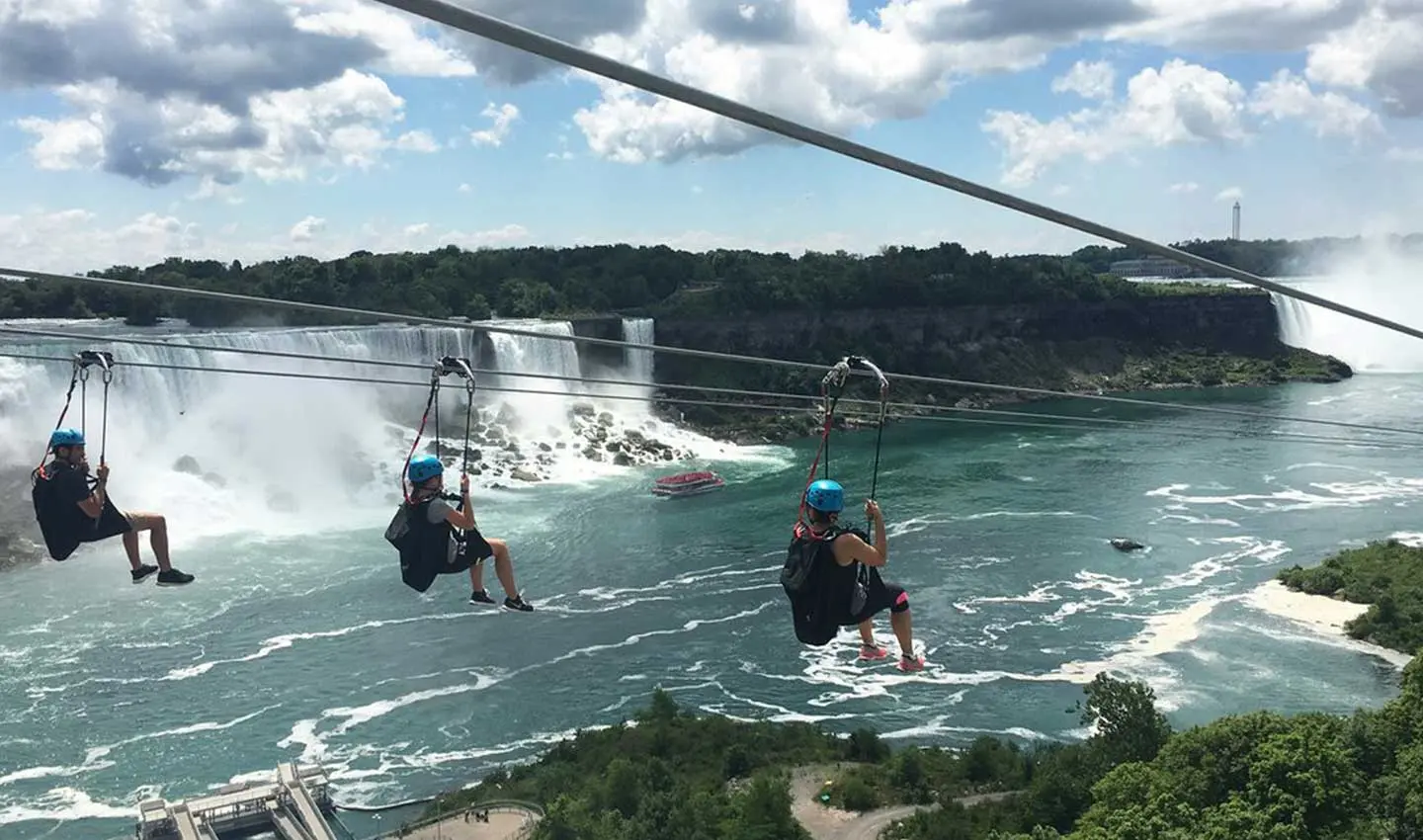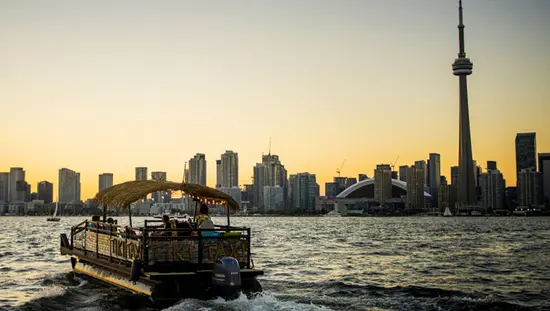CN Tower
Standing 533 metres tall and towering above the rest of Toronto’s skyline, the CN Tower is a historical and cultural icon of the city and country. Considered one of the world's great engineering feats, the Tower was the tallest structure in the world for over 30 years, from 1975 until 2007.
A top family attraction, you’ll enjoy seeing panoramic city views from the high vantage point of the Top or the dining windows in the Tower’s 360 Restaurant. If you’re the adventurous type, try walking along the Tower’s outdoor ledge with the CN Tower’s EdgeWalk.
CN Tower | Destination Toronto
How to get to CN Tower
Location: 290 Bremner Boulevard, Toronto
By transit: Union Station is the main transit access point to the CN Tower. Find directions online and plan your visit to the CN Tower.
By car: Several paid parking options are available nearby, including the Metro Toronto Convention Centre and the Impark lot on Navy Wharf Court.
Know before you go
Save money on admission by purchasing a Toronto CityPASS.
Purchase your CN Tower tickets in advance online or at the door. Children aged two years and younger receive complimentary admission.
Visit the CN Tower’s Common Questions page for more information.
Things to do at CN Tower
Discover more activities and experiences.
Dining with a view
Book a table at 360 The Restaurant at the CN Tower, which offers exceptional food paired with a revolving view of Toronto from over 350 metres above the ground.
Thrill-seeking activities
See Toronto and Lake Ontario from above while walking the CN Tower EdgeWalk, the world’s highest full circle hands-free walk at 350 metres above the ground.
Visit the highest viewing deck
Feel the CN Tower sway in the wind in the Top, the highest observation platform in the Western Hemisphere. This unique attraction is located 33 storeys higher than the main deck.
Have a toast
Celebrate your life’s milestones with the CN Tower’s 360 celebration packages. From a romantic dinner for two to a fun charcuterie party, you’ll find options to suit every occasion.
Spot city landmarks
The Main and Lower Observation Levels feature window walls in all directions, providing uninterrupted views of the city.
Take memorable pictures
Take a walk on the two-tiered Glass Floor or lean over the tilted glass at the OverView stations. The Tower is the perfect backdrop for taking photographs.
Articles and itineraries
Get ideas and inspiration for your next trip.

Interesting facts about the CN Tower
The “CN” in CN Tower stands for Canadian National, the railway company that built the Tower between 1973 and 1976. From the Tower, viewers can see as far as Niagara Falls on a clear day.
In addition to being a tourist spot, the CN Tower is the centre of telecommunications for the southern Ontario region, serving more than 17 Canadian television and FM radio stations. It provides much-needed cell signal to millions of people in the city of Toronto and the surrounding Greater Toronto Area.
A time capsule is embedded in the Tower’s walls and will be opened on its 100th birthday in 2076.
Accessibility Features
Accessible drop off location
A designated and signed area used for loading and unloading passengers into or out of a waiting vehicle. A passenger drop-off/pick-up area typically should include a driveway, a lay-by for the stopped vehicle close to an accessible entrance and an accessible route from the drop-off/pick-up area to the main entrance. It is important that any drop-off locations are clear of snow and ice or other obstructions.
Accessible outdoor eating area
Places located outside where members of the public can sit at a table and eat (for example, outdoor food courts at amusement parks or picnic tables in parks). This includes accessible tables with enough clear space around and under so that people using a wheelchair or other mobility aid can easily access. Also, the ground leading to and under the accessible tables is level, firm and stable.
Accessible restaurant
Designed to be accessible to persons with varying disabilities, including those using mobility aids. They include an accessible entrance, adequate maneuvering space, nearby accessible washrooms, tables with removable chairs and sufficient knee clearance, menus in alternate formats, and cafeteria or buffet counters that are reachable for mobility device users.
Accessible seating
For persons using mobility aids, accessible seating is available in all areas or levels for persons using mobility aids. The path to the accessible seating should be barrier-free so a person using a mobility device can access it. Reserved space with a clear view of the event/activity for someone who is seated, good sound quality and adequate maneuvering room for a mobility device.
Automatic doors
Main entrance doors and other accessible entrances and exits are power assisted to allow easy access.
Easy access electrical outlets
At least one electrical outlet is within easy reach and has clear floor space in front for charging an electric mobility device.
Elevator access
Elevators should be designed to be usable independently by and accessible to persons using wheelchairs, scooters, walkers, canes or crutches, to enter and exit all public facilities. Controls/buttons should include tactile information to ensure easy use by persons who have visual limitations. Controls/buttons should be easy to reach and push, be raised and require minimal strength to activate.
Ramps
An inclined plane that allows wheelchair users and others to access buildings and navigate between different levels.
Sensory-friendly areas
Crafted to minimize overwhelming sensory input. This includes features like dimmed lighting, noise-cancelling options and calming textures.
Wide doorways and hallways
A sufficiently wide, hard-surfaced, unobstructed path to allow for easy travel.
Accessible washroom
At least one washroom stall larger than the others to accommodate adequate maneuvering space for mobility devices. They also include grab bars, transfer space, an accessible door latch, sink with knee clearance, and lever handles or automatic sensor faucets.
Universal washroom
A separate washroom that allows an individual in a wheelchair to use a self-contained washroom facility. They include grab bars, transfer space, an accessible door handle/lock, accessible sink with knee clearance, easy-to-use/automatic faucets, adult change table and emergency call systems. It is also universal, allowing people of any gender to use it comfortably, including with a support person if needed.
Assistive listening devices available
Assistive listening devices are available for rent or free of charge. You can select this feature if you offer assistive listening devices to help people with hearing loss better hear a performance or event. These devices can include frequency modulation (FM) systems, infrared systems and audio induction loop systems. It is important to check the devices periodically to ensure that they are in good working order (i.e., working batteries and not in need of maintenance).
Information available in alternative format
Alternative formats present information beyond standard text, such as electronic text, audio, captioning and Braille. Accessible formats are available for menus, brochures, maps, signage or websites. Communication support must be provided in a timely manner upon request, at no extra charge, in consultation with the person making the request.
Service animals welcome
Can be identified by visual indicators (such as a vest or harness) or documentation from a regulated health professional confirming the animal is necessary due to a disability. In Ontario, service animals are allowed in all public spaces unless otherwise prohibited by law. A service animal is not a pet; it is trained to perform tasks to assist a person with a disability, such as guiding individuals with vision impairments, alerting to sounds for those with hearing impairments, assisting during seizures, retrieving items, or helping manage psychiatric and neurological disabilities. There are no restrictions on the type of animal used as a service animal in Ontario. If the animal is not easily identifiable, the person can provide documentation from a regulated health professional confirming the need for the service animal.
Support persons welcome
By law, you must allow a person with a disability to be accompanied by his or her support person while in the areas of your business that are open to the public. A support person is an individual hired or chosen by a person with a disability to provide services or assistance with communication, mobility, personal care, medical needs or with accessing goods, services or facilities. If you charge an admission fee at your business, you must let people know you charge an additional fee for a support person.
Wheelchair and/or mobility devices available
Mobility devices such as wheelchairs, walkers, canes or mobility scooters are available for people to borrow or rent at the business. If you make wheelchairs or assistive devices available to the public, it is important to make sure that they are properly maintained and periodically serviced so they are in good working order and do not present a safety risk.
Emergency communication systems
Providing alerts and information in multiple formats including text-based alerts, audio messages and visual cues.
Evacuation chairs
Compact and foldable mobile chairs used to evacuate people with disabilities down the stairs. Evacuation chairs may be manually operated or have a battery-powered motor.
Last updated: November 14, 2025




























